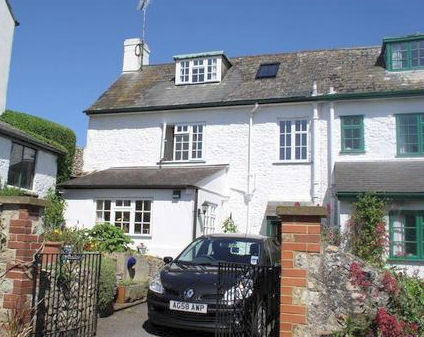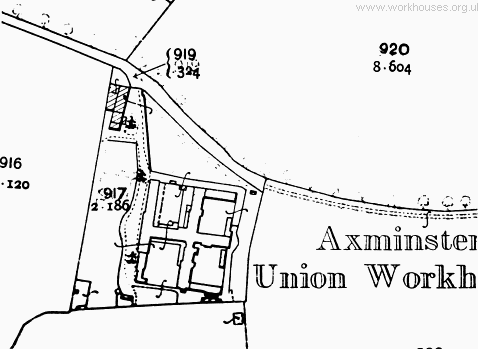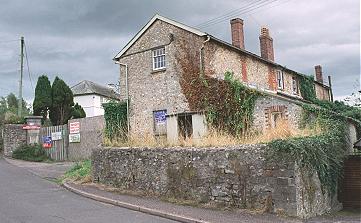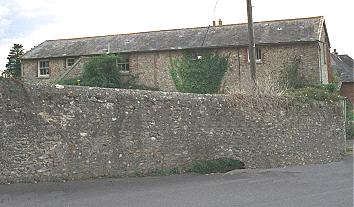Axminster, Devon
Up to 1834
Thorncombe had a workhouse from 1734. It had 32 inmates in 1740 and 60 in 1776.
Lyme Regis had a workhouse from at least 1738. It stood at what is now the site of 33-34 Coombe Street, opposite the Ship Inn. The account book for 1738-1747, compiled by the master, Stephen Turner, lists the weekly expenditure on food, medicine, clothes, work materials, funeral payments etc. Items mentioned in 1738 include 3lbs of butter costing 1s. 1½d.; 2lbs of tobacco, 1s. 8d.; a peck of peas, 3d.; 12 bushels of coal, 18s.; and 34½ yards of linen, £1 4s. 5¼d. (8½d. per yard). The midwife charged 2s. 6d for each (usually illegitimate) delivery. Funeral charges typically amounted to about 7s. 6d. The establishment brewed its own beer and kept a pig. Oakum-picking and weaving appear to have been among the main employments. In 1739, 238lbs. of 'junk' (old rope) cost 14s. — a much more expensive item than the wages for picking it (l0¾d. for 250lbs. of oakum in 1743). Out-relief payments for medicine such as salves and itchwater were quite frequent. One such payment was for 'the children of the idiot'. In 1776, the workhouse could hold up to 32 inmates.
Axminster's first workhouse was opened in 1738 on West Street, opposite the entrance steps to the churchyard. In 1776, it could accommodate 80 inmates. After being burned down in 1789, it was rebuilt on the same site and in 1792 was described as 'a large, airy, good house for the poor'.
A parliamentary report of 1777 also recorded parish workhouses in operation at Colyton (for up to 66 inmates ), Membury (18), Seaton and Beer (24), Stockland (30) and Uplime (10).
In around 1810, Charmouth erected a workhouse at the west of the village, at the north side of what is now Old Lyme Hill.

Part of Charmouth's former workhouse.
After 1834
Axminster Poor Law Union was formed on 16th April 1836. Its operation was overseen by an elected Board of Guardians, 25 in number, representing its 17 constituent parishes as listed below (figures in brackets indicate numbers of Guardians if more than one):
Devon:
Axminster (3), Axmouth, Beer and Seaton (2), Colyton (2), Combe Pyne, Kilmington, Membury, Musbury, Shute, Thorncombe (2), Uplyme.
Dorset:
Charmouth, Chardstock (2), Dalwood, Hawkchurch, Lyme Regis (3), Stockland.
The population falling within the union at the 1831 census had been 19,490 - ranging from Membury (population 370) to Axminster itself (2,719). The average annual poor-rate expenditure for the period 1833-36 had been £10,218.
The new Axminster union workhouse was built in 1836-38 for 300 inmates for which the Poor Law Commissioners authorised an expenditure of £4,650. Situated to the south of the town, on the south side of Boxfield Road, the building was to one of the Poor Law Commissioners' standard square designs by Sampson Kempthorne. Its layout is shown on the 1905 map below:

Axminster workhouse site, 1905.
In 1894, the British Medical Journal set up a "commission" to investigate conditions in provincial workhouses and their infirmaries. Following a visit to Axminster, the commission's report had many criticisms of the institution. The sick wards were described as "crowded and destitute of comfort, the bedsteads narrow and low, the red quilts much too heavy; the windows are small and placed high in the wall." The workhouse was entirely devoid of indoor water-closets and the only conveniences for the sick were commodes in the wards. No running water was laid on for the sick wards and the workhouse's sole bath had only a supply of cold water. Any hot water required was carried from the kitchens. There was just one nurse, assisted by paupers, with no night-nurse being employed. The report recommended the building of a small, well-equipped infirmary. More immediately, earth or water closets should be installed, and an additional nurse or nursing assistant appointed. Further details are available in the full report.
From 1904, to protect them from disadvantage in later life, the birth certificates for those born in the workhouse gave its address just as Box House, Musbury Road, Axminster.
In 1930, the site was taken over by Devon County Council and became a Poor Law Institution. From around 1933, it was used to accommodate 'mentally defective' inmates and adopted the name Box House. In 1948, it joined the National Health Service as Box House Hospital, renamed St Mary's Hospital in 1971. The former workhouse buildings have mostly been been demolished and replaced by modern housing. A surviving block near the former entrance to the site may have housed a vagrants' ward.

Axminster entrance block from the north-west, 2000.
© Peter Higginbotham.

Axminster entrance block from the east, 2000.
© Peter Higginbotham.
Staff
Inmates
Records
Note: many repositories impose a closure period of up to 100 years for records identifying individuals. Before travelling a long distance, always check that the records you want to consult will be available.
- Dorset History Centre, Bridport Road, Dorchester DT1 1RP. Has Lyme Regis workhouse account books (1738-48, 1800-02, 1811-12; catalogue section PE/LR/OV5)
- Devon Heritage Centre, Great Moor House, Bittern Road, Sowton Exeter EX2 7NL. Few local union records survive. Main holdings are Guardians' minutes (1836-1932).
Bibliography
- Shipp, Arnold (2013) Poor Relief in Thorncombe 1722-1809. An introductory Survey of the Overseers' and Workhouse Accounts
Links
- BMJ Report on Axminster Workhouse and Infirmary, 1895
- The union's early correspondence with the central poor-law authorities is online on the TNA website .
Acknowledgment
- Many thanks to David Tucker and Lyme Regis Museum for information on the Lyme Regis workhouse.
Unless otherwise indicated, this page () is copyright Peter Higginbotham. Contents may not be reproduced without permission.


